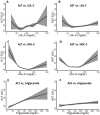Low LDL-C and high HDL-C levels are associated with elevated serum transaminases amongst adults in the United States: a cross-sectional study
- PMID: 24454851
- PMCID: PMC3893181
- DOI: 10.1371/journal.pone.0085366
Low LDL-C and high HDL-C levels are associated with elevated serum transaminases amongst adults in the United States: a cross-sectional study
Abstract
Background: Dyslipidemia, typically recognized as high serum triglyceride, high low-density lipoprotein cholesterol (LDL-C) or low high-density lipoprotein cholesterol (HDL-C) levels, are associated with nonalcoholic fatty liver disease (NAFLD). However, low LDL-C levels could result from defects in lipoprotein metabolism or impaired liver synthetic function, and may serve as ab initio markers for unrecognized liver diseases. Whether such relationships exist in the general population has not been investigated. We hypothesized that despite common conception that low LDL-C is desirable, it might be associated with elevated liver enzymes due to metabolic liver diseases.
Methods and findings: We examined the associations between alanine aminotransferase (ALT), aspartate aminotransferase (AST) and major components of serum lipid profiles in a nationally representative sample of 23,073 individuals, who had no chronic viral hepatitis and were not taking lipid-lowering medications, from the National Health and Nutrition Examination Survey (NHANES) from 1999 to 2010. ALT and AST exhibited non-linear U-shaped associations with LDL-C and HDL-C, but not with triglyceride. After adjusting for potential confounders, individuals with LDL-C less than 40 and 41-70 mg/dL were associated with 4.2 (95% CI 1.5-11.7, p = 0.007) and 1.6 (95% CI 1.1-2.5, p = 0.03) times higher odds of abnormal liver enzymes respectively, when compared with those with LDL-C values 71-100 mg/dL (reference group). Surprisingly, those with HDL-C levels above 100 mg/dL was associated with 3.2 (95% CI 2.1-5.0, p<0.001) times higher odds of abnormal liver enzymes, compared with HDL-C values of 61-80 mg/dL.
Conclusions: Both low LDL-C and high HDL-C, often viewed as desirable, were associated with significantly higher odds of elevated transaminases in the general U.S. adult population. Our findings underscore an underestimated biological link between lipoprotein metabolism and liver diseases, and raise a potential need for liver evaluation among over 10 million people with particularly low LDL-C or high HDL-C in the United States.
Conflict of interest statement
Figures


Similar articles
-
Erosive esophagitis associated with metabolic syndrome, impaired liver function, and dyslipidemia.World J Gastroenterol. 2013 Sep 21;19(35):5883-8. doi: 10.3748/wjg.v19.i35.5883. World J Gastroenterol. 2013. PMID: 24124334 Free PMC article.
-
Correlation of Toll-like receptor 4, interleukin-18, transaminases, and uric acid in patients with chronic periodontitis and healthy adults.J Periodontol. 2015 Mar;86(3):431-9. doi: 10.1902/jop.2014.140414. Epub 2014 Oct 27. J Periodontol. 2015. PMID: 25345339
-
Prevalence of lipid abnormalities in the United States: the National Health and Nutrition Examination Survey 2003-2006.J Clin Lipidol. 2012 Jul-Aug;6(4):325-30. doi: 10.1016/j.jacl.2012.05.002. Epub 2012 May 22. J Clin Lipidol. 2012. PMID: 22836069
-
Prebiotic and probiotic treatment of nonalcoholic fatty liver disease: a systematic review and meta-analysis.Nutr Rev. 2018 Nov 1;76(11):822-839. doi: 10.1093/nutrit/nuy031. Nutr Rev. 2018. PMID: 30113661
-
AST to ALT ratio and arterial stiffness in non-fatty liver Japanese population:a secondary analysis based on a cross-sectional study.Lipids Health Dis. 2018 Dec 3;17(1):275. doi: 10.1186/s12944-018-0920-4. Lipids Health Dis. 2018. PMID: 30509277 Free PMC article. Review.
Cited by
-
Investigating the prevalence and associated factors of elevated liver enzymes and dyslipidemia during pregnancy.Sci Rep. 2025 Feb 1;15(1):3967. doi: 10.1038/s41598-025-88798-4. Sci Rep. 2025. PMID: 39893319 Free PMC article.
-
Steatohepatitis and liver fibrosis are predicted by the characteristics of very low density lipoprotein in nonalcoholic fatty liver disease.Liver Int. 2016 Aug;36(8):1213-20. doi: 10.1111/liv.13076. Epub 2016 Feb 24. Liver Int. 2016. PMID: 26815314 Free PMC article.
-
A Population-Based Cross-Sectional Study of the Association between Liver Enzymes and Lipid Levels.Int J Hepatol. 2018 Jun 3;2018:1286170. doi: 10.1155/2018/1286170. eCollection 2018. Int J Hepatol. 2018. PMID: 29973996 Free PMC article.
-
Prediction of the risk of cytopenia in hospitalized HIV/AIDS patients using machine learning methods based on electronic medical records.Front Public Health. 2023 Jul 28;11:1184831. doi: 10.3389/fpubh.2023.1184831. eCollection 2023. Front Public Health. 2023. PMID: 37575113 Free PMC article.
-
Association between Serum Liver Enzymes and Metabolic Syndrome in Korean Adults.Int J Environ Res Public Health. 2018 Aug 5;15(8):1658. doi: 10.3390/ijerph15081658. Int J Environ Res Public Health. 2018. PMID: 30081587 Free PMC article.
References
-
- Mahley RW, Innerarity TL, Rall Jr SC, Weisgraber KH (1984) Plasma lipoproteins: apolipoprotein structure and function. J Lipid Res 25: 1277–1294. - PubMed
-
- Liangpunsakul S, Chalasani N (2005) Unexplained elevations in alanine aminotransferase in individuals with the metabolic syndrome: results from the third National Health and Nutrition Survey (NHANES III). Am J Med Sci 329: 111–116. - PubMed
-
- Younossi ZM, Stepanova M, Afendy M, Fang Y, Younossi Y, et al... (2011) Changes in the prevalence of the most common causes of chronic liver diseases in the United States from 1988 to 2008. Clin Gastroenterol Hepatol 9: 524–530 e521; quiz e560. - PubMed
Publication types
MeSH terms
Substances
Grants and funding
LinkOut - more resources
Full Text Sources
Other Literature Sources
Medical

